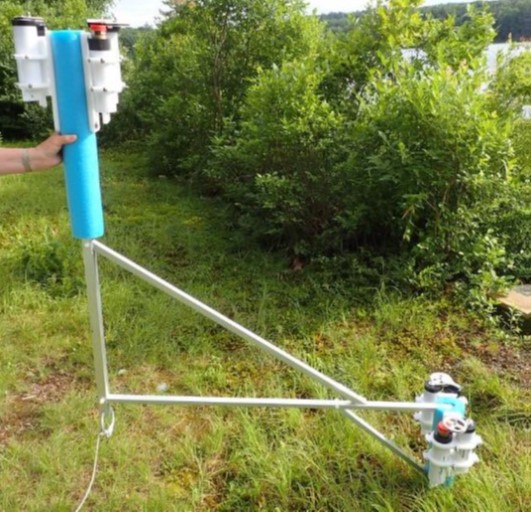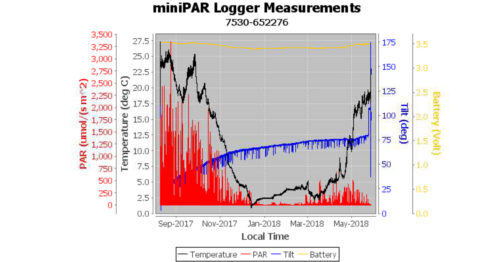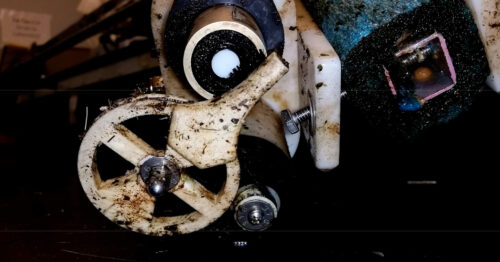
Measuring Dissolved Oxygen Levels in Seawater
May 21, 2019
The White Abalone Restoration Consortium
June 25, 2019Measuring Diffused Sunlight in Lakes
Project Details
- PRODUCT(S): miniDOT® Logger, miniPAR Logger, miniWIPER for miniPAR Logger
- APPLICATION: Surface Water
- PARAMETER: Diffused Sunlight, Dissolved Oxygen
- LOCATION: Pocono Region of Pennsylvania
- ORGANIZATION: Scripps Institution of Oceanography
- RECOGNITION: Rachel Pilla, Miami University

Using miniPARS to Measure Diffused Sunlight in a Pocono Lake
Rachel Pilla of Miami University is deploying PME’s miniPAR loggers to measure photosynthetically active radiation (PAR) in a lake located in the Pocono region of Pennsylvania. Her lab has been studying the lake for over 30 years.
She deployed the miniPAR sensors in the summer of 2018, with a particular interest in studying year-round patterns in incoming radiation and light attenuation. The sensors remain deployed through the winter, collecting under-ice PAR data, which will allow Pilla and her collaborators to understand the light absorbing properties of winter ice and snow, lake water transparency under ice, and the potential implications for the balance of oxygen production by photosynthesizing algae vs oxygen depletion by respiring organisms.

Seasonal Turnover and Subsequent Spikes
The miniPARs are each paired with PME’s miniWIPERs, which serve as anti-fouling devices and help reduce the growth of a variety of organisms, allowing the sensors to stay accurate for longer periods.
The team has also been using PME’s miniDOT loggers to measure dissolved oxygen levels in the lake water as part of a project Pilla is leading for the Global Lake Ecological Observation Network (GLEON), compiling high-frequency data on oxygen depletion in lakes, with a focus on the regulatory role of water transparency on oxygen depletion during ice cover and during summertime.
As depicted in the photo below, the set-up deployed in the Pocono lake features one miniPAR and one miniDOT, one for measuring light and the other for measuring oxygen, each (at the top and bottom-right of the photo), situated 0.5m and 1.5m deep in the water column. The team developed this set-up to avoid self-shading interference in the PAR readings and to ensure an accurate distance between the two miniPARS, which is required for precise calculations of light attenuation.
Findings, GLEON, and LTREB
 Though Pilla has analyzed only one year of preliminary miniPAR data, she’s already seeing intriguing initial patterns which suggest fluctuation in water transparency, particularly during the fall and spring seasons. During winter, even though light penetration through the ice and snowpack looks to be very low, the water transparency seems relatively stable until the spring thawing period. Pilla plans to present her findings at the November conference of GLEON. She also expects to publish them in a scientific journal following completion of the project. The miniPAR data will likely also be incorporated into one or more projects funded by a National Science Foundation (NSF) Long Term
Though Pilla has analyzed only one year of preliminary miniPAR data, she’s already seeing intriguing initial patterns which suggest fluctuation in water transparency, particularly during the fall and spring seasons. During winter, even though light penetration through the ice and snowpack looks to be very low, the water transparency seems relatively stable until the spring thawing period. Pilla plans to present her findings at the November conference of GLEON. She also expects to publish them in a scientific journal following completion of the project. The miniPAR data will likely also be incorporated into one or more projects funded by a National Science Foundation (NSF) Long Term Research in Environmental Biology (LTREB) program.
Ongoing Research
 Pilla’s team plans to continue deploying miniPAR/miniWIPER combinations to track seasonal patterns in incoming radiation and water transparency over the next several years as part of the LTREB-funded program. The data gathered will likely also be a core component of the project she is leading for GLEON. “As we continue to collect more data from the miniPARs,” Pilla said, “there are numerous potential empirical or modeling applications for which I anticipate the loggers will be invaluable.” For more information on how miniPARs, miniWIPERs, miniDOTs and other PME products can assist you in your next project, contact us today.
Pilla’s team plans to continue deploying miniPAR/miniWIPER combinations to track seasonal patterns in incoming radiation and water transparency over the next several years as part of the LTREB-funded program. The data gathered will likely also be a core component of the project she is leading for GLEON. “As we continue to collect more data from the miniPARs,” Pilla said, “there are numerous potential empirical or modeling applications for which I anticipate the loggers will be invaluable.” For more information on how miniPARs, miniWIPERs, miniDOTs and other PME products can assist you in your next project, contact us today.
Product Description
The miniPAR logger is a portable, submersible instrument for measuring diffused sunlight through water or Photosynthetically Active Radiation (PAR). The miniPAR also contains a temperature sensor as well as a tilt sensor to ensure proper orientation. Data are recorded to an internal SD card. The miniPAR is powered by two AA batteries and can be fitted with an anti-fouling miniWIPER to protect long-term accuracy.
The miniWIPER is a self-contained, completely submersible wiping device which can be used with a variety of sensors. It can be programmed to wipe at various intervals and is powered by AA Lithium batteries. A small brush rotates over the sensor, performing a complete wipe of the sensor surface, then rests away from the sensor to allow for accurate and continuous monitoring.
The miniDOT logger is a completely submersible instrument that logs dissolved oxygen and temperature measurements. The oxygen sensor is an outpode that measures dissolved oxygen concentration in water through a fluorescence method. Data are recorded to an internal SD card. Setting the time and sample interval can be accomplished via USB cable.

